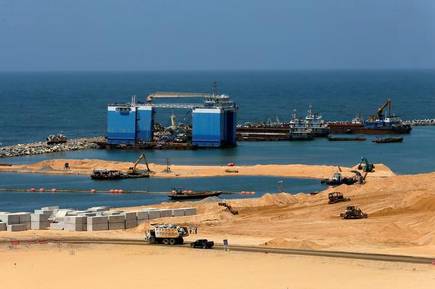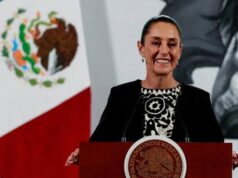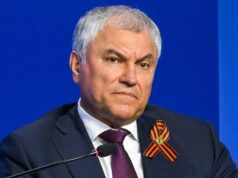Eastern Container Terminal Controversy : What Sri Lankans Think

Sri Lanka, India and Japan signed a Memorandum of Cooperation (MoC) on May 28, 2019
On Tuesday, the Sri Lankan Government said it was withdrawing from an agreement with Japan and India to develop a deep-sea container terminal at the Colombo Port. Why is this agreement or the terminal important? And how is India reacting to this development?
The Sri Lankan Government this week announced that it would withdraw from the much-hyped agreement with Japan and India to develop the East Container Terminal (ECT) at the Colombo Port. The tripartite agreement proposed to develop the ECT, located at the newly expanded southern part of the Colombo Port. The recent controversy aside, the ECT is one of Sri Lanka’s greatest economic opportunities and is therefore attracting the attention of many in the region. The agreement was also viewed as an effort to counter China’s influence in the region, because the Colombo Port remains a strategic point in China’s Belt and Road Initiative.
What is the agreement?
India, Sri Lanka and Japan signed a Memorandum of Cooperation (MoC) on May 28, 2019, during the tenure of former President Maithripala Sirisena, to develop the ECT. It attracted controversy at the time with President Sirisena objecting to any Indian involvement, despite the deal being under negotiation for a lengthy period of time.
According to the MoC, the Sri Lanka Ports Authority (SLPA) was to retain 100% ownership of the ECT. The Terminal Operations Company, the entity responsible for its operations, will be jointly owned with Sri Lanka holding a 51 per cent stake.
India and Japan was to hold the remaining 49 per cent — with 24 per cent by Japan holding and 15 per cent by India. The project was estimated to cost between 500 and 700 million US dollars and it was to be funded by Japan, though the Yahapalana government failed to proceed with the negotiations.
Why the Eastern Container Terminal?
The Colombo Port is one of the busiest ports in the world and topped the rankings as the fastest growing port in 2018 by industry analyst Alphaliner, which provides regular updates and rankings of the 100 largest container/liner operators. JOC Group Inc, another provider of global intelligence for trade, transportation and logistics professionals listed Colombo Port as the 24th among the top 50 global container ports in 2018. In 2019 however Colombo Port dropped to 25th place, it being attributed to the infrastructural delays the Port has been experiencing.
Japan has previously aided in the development of the Colombo Port, with both financial and technical assistance, especially in the development of the Jaya Container Terminal since the 1980s. In the meantime India is said to be keen on pushing this deal through, as some 70 per cent of the transshipment business at the Colombo port is linked to India.
The development of the ECT has been in the talks since 2013 when the initial 400 metres of the 1,200-metre jetty was completed. Tenders were called for container handling cranes. But in 2015, with the Yahapalana government elected to power, the then Minister of Ports and Shipping scrapped the call for tenders, stating that the process was mired in corruption.
The controversial deep-sea jetty is also located next to the Colombo International Container Terminal and commissioned in 2013. This terminal is 85 per cent owned by China while the SLPA owns the remaining 15 per cent. Both India and the United States have expressed concerns over China’s visible stronghold in the region, including Sri Lanka’s sea ports.
Why backtrack?
In the wake of Sri Lanka’s inability to repay the colossal loans from China, in December 2017, Sri Lanka permitted China Merchants Port Holdings control over the deep sea port in Hambantota, located along the world’s busiest East-West shipping route.
Since then the government has faced constant criticism and opposition from local groups, especially the trade unions. The government’s announcement of its decision to pull out from the agreement came against the background of some 23 Trade Unions resorting to a work-to-rule campaign against the agreement, granting the ECT to an Indian conglomerate for development,.
In an attempt to pacify local protests, a proposal to develop the West Terminal at the Colombo Port – instead of the Eastern Terminal — as a Public Private Partnership with India and Japan was announced by the government following a Cabinet Meeting on Tuesday. The government said it would instead develop the site “as a wholly-owned container terminal of the Sri Lanka Ports Authority” for US$800 million.
The decision came less than a month after an official visit by Indian Foreign Minister S. Jaishankar in an attempt to move the deal forward. Following the announcement, New Delhi has quite frankly asked Sri Lanka to honour the agreement to develop the Eastern Container Terminal, not the Western Terminal.
Sri Lanka is already in hot water, and has been for some time now, with credit agencies cutting the country’s debt ratings. Still reeling from the economic impact of the 2019 Easter Sunday bombings, followed by pandemic lockdowns it is reported that the government is expecting more Chinese loans this year. The withdrawal from the agreement has certainly soured Sri Lanka’s relations with India, and perhaps may even signal difficult times ahead for the country’s already struggling economy.




